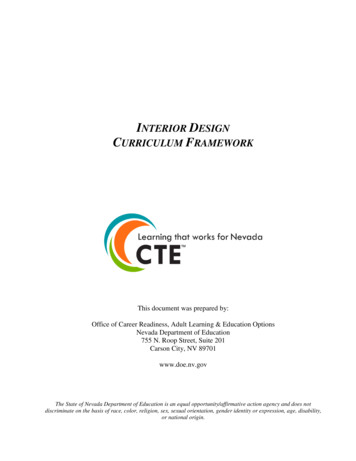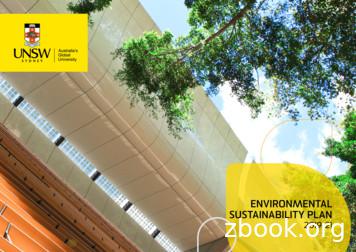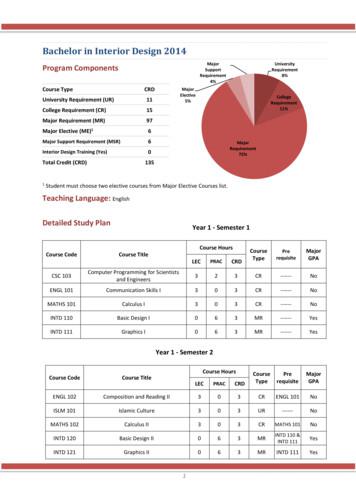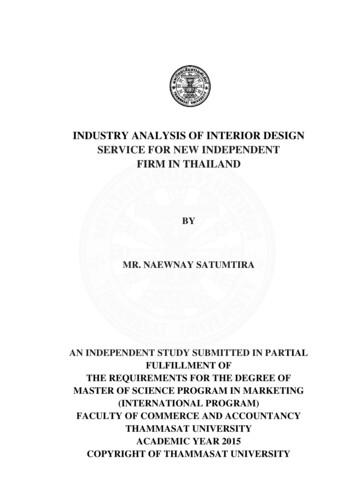Environmental Sustainability In Interior Design Elements
Recent Researches in Environmental and Geological SciencesEnvironmental Sustainability in Interior Design ElementsNUR AYALPInterior Architecture and Environmental DesignTOBB Economy and Technology UniversitySogutozu Street No:43, Sogutozu, Ankara, 06560TURKEYnayalp@etu.edu.trAbstract: - Interior design is a profession that serves for the human habitation in the environment. In thecontext of human needs, there are many different dimensions and levels of satisfaction. The interior space cansatisfy the need of security, or it can lead to a satisfaction level from security to self-esteem. Recent globaldebates focus on to a basic need that is to survive. Need of sustainable environment is an obligation rather thana will, in order to survive. This study aims to discuss the interior design elements in the dimension ofsustainability. The practice of interior design is also considered in the context of sustainability.Key-Words: - Sustainability, Interior Design, Interior Design Elementsobtained without jeopardizing the natural systemson which life on the earth is dependent” [1].1 IntroductionAfter the industrial revolution, technologicaldevelopments dominated our daily life. Peoplemigrated from villages to industrial sites and cities.In time, the balance between the land and theoccupied area has changed. On the way of creatingnew sites, natural areas are heavily destroyed.Moreover, the number of occupancy per dwellingdecreased. “Simultaneous with a decrease in thenumber of occupants per dwelling, the average sizeof dwellings has increased” [1]. At the same time,the amount of fuel consumption increased everyyear.In problem formation, sustainable development hasmany different dimensions from social to political.Among these, environmental sustainability is thedimension that is in bilateral relation with otherdimensions. In this context, humans have a curialresponsibility in creating sustainable environments.Interior designers create environment for theoccupation of human. That is, interior environmentis the first and the closer place to fulfill humanneeds. This study focuses on the interior designdimension of sustainability within the context ofdesign elements.With all these changes, especially after the oil crisisin 1970, researchers started to focus their studies onthe cure to ecological balance in nature. The termbecame important in political, social, and scientificstudies. In these studies, techno-centric approachwas dominant starting from 19th century up to themiddle of 20th century. Then the antro-centricapproach took place, centered to human. Today, thestudies focused on the ecological system [2].2 Sustainability in Built EnvironmentThe term of sustainability is not just a theoreticalcourse, but it is also a very technical term in the faceof problem solution. As Sassi defined“Sustainability is not an academic pursuit or even aprofessional activity: it is a way of life affectingeverything an individual does. Knowing what kindof a relationship we want to have with the globaland local environment is the first consideration.Then, we should address how to achieve thisrelationship. To move from theory into practice, it isnecessary to understand the impacts associated withour work and life related activities” [3].Sustainable development became a significantproblem in international commissions. Especially,Bruntland Commission in 1987 declared a reportabout the leading items in sustainable development.The definition of need was redefined with this reportas “sustainable development is first and foremostabout ensuring that everybody-both in poor and richcountries, and today as well as in future generationscan have their basic needs meet. This must beISBN: 978-1-61804-110-4163
Recent Researches in Environmental and Geological SciencesIn the dimension of environmentally sustainabledevelopment, Ness classified the theoretical studiesunder five topics as:6. Materials: evaluation from the aspect of materiallife cycle.7. Waste: waste products.8. Land use and Ecology: conservation of ecologicalsites.9. Pollution: air and water pollution assessments.1. Reduction of the energy and emission in theenvironment.2. Minimizing the distraction in the ecological,natural ion areas for food production.3. Minimizing the consumption of environmentallyharmful construction materials.4. Recycling natural resources.5. Preventing sound and air pollution in order toprotect the inhabited health.In LEED, the categories of evaluation is under sixtopics as:1.2.3.4.5.6.The factors related to the minimization of use ofharmful construction materials, recycling andpreventing pollution are the most important aspectsof sustainability in the context of interior design.When these categories are considered from theperspective of interior design, it is obvious that thedesign elements are the major substances in gainingsustainable interior environments.In European Union Countries, total 40%consumption of energy, 30% of CO2 gas emission,and 40% of synthetic waste are produced in theconstruction industry [4]. That means, theenvironmental design has a big role in the course ofsustainable development. Moreover, 50% of naturalmaterial resources is used in the constructionindustry. From this perspective, there occurred theneed of developing suitable assessment criteria forbuilt environments.3 Sustainability in Interior DesignElementsAs a profession, designing interior environmentscan be defined as “determining the relationship ofpeople to spaces based on psychological andpsychical parameters, to improve the quality of life”[6]. In the core of sustainability, these physicalparameters gain importance in the means of longterm use.The assessments tools aim to provoke designer andconstruction industry to serve environmentalsustainability. There are many assessments tool suchas BREEAM (England), SBTool (International),LEED (USA), EcoProfile (Norvey), Promise(Finland), Green Mark of Buildings (Singapore),Green Star (Australia), CASBEE (Japan). Amongthese, the widely used assessment tools areBREEAM and LEED.Sustainable interior design is defined as “interiordesign in which all systems and materials aredesigned with an emphasis on integration into awhole for the purpose of minimizing negativeimpacts on the environment and occupants andmaximizing positive impacts on environmental,economic and social systems over the life cycle of abuilding” [7].The first example is BREEAM which is establish in1990 as Building Research EstablishmentEnvironmental Assessment Method by BuildingResearch Establishment. This assessment systemevaluates the building in the context ofsustainability under nine main topics as:Kang and Guerin defined the sustainable interiordesign practice in three dimensions as: globalsustainable interior design, indoor environmentalquality, and interior materials. The indoorenvironmental quality, that is also an assessmentcategory in the LEED, is the most importantimplication in considering the sustainability ofinterior environments. Improving indoor air qualitywhich is mainly the activity of reducing indoorpollutants, improves the thermal comfort and qualityof interior lighting. Moreover, using materials thosecan have the possibility of recycling is another1. Management: in the dimension of policy of sitemanagement.2. Health and wellbeing: Factors affecting the healthand wellbeing.3. Energy: energy consumption and gas emission.4. Transport: transportation in the context oflocation and gas emission.5. Water: efficiency in water consumption.ISBN: 978-1-61804-110-4Sustainable site developmentWater efficiencyEnergy efficiencyMaterial selectionIndoor environmental qualityInnovation and design process [5].164
Recent Researches in Environmental and Geological Sciencescriteria in obtaining sustainability. In consideringthese aspects, most essential interior designelements are materials, furnishing, and lighting.production process and the long term use of thefurniture are the major criterions.Wood products are widely used materials in thefurniture production. They can be recycled actually.However, some synthetic materials used in the woodproduction process cannot be recycled. Moreover,the wastes occurred in the production processdamages the nature. These waste products containsame toxic polymer based synthetic materials. Therate of the waste to the product is about 30% of thetotal amount of the product [9].3.1. Interior Design Element: MaterialsIn material selection, the most important criteria isto select the material according to the features offunction. Each of every function has specific needs.As an example, materials used in the hospitalinterior and the shopping mall should be differentdue to the sterilization aspect. Especially, theselection should aim to long term use. It is veryimportant to use a material in its maximum potentialin order to reduce waste of resources.Rather than the production process, the old furniturealso cannot be recycled. These wastes have a bigrole in increasing the amount of global waste.Achieving sustainable furniture, recycling is one ofthe important criterion. Recently, some of thefurniture companies started producing furnituretotally from waste.As, in the process of producing materials, the energyis used. This is called as the embodied energy. Eachmaterial has different amount of embodied energy.For example, concrete, steel and the plastics arehigher in embodied energy amount in theconstruction materials. Especially, natural materialssuch as stone and timber gradually have lessembodied energy.Another important criterion in material selection isthe recycling potential of the materials. There aremany studies in the field of waste managementwhich aim to innovate new construction materials.A Cierra Recycling can be an example to one ofthese. Basically, they collect and separate the waste,and then they transform it and remanufacture thesewaste products [8].Moreover, the level of emission of toxic gases bothused in production process and during the usingperiod of the materials is an essential criterion inachieving sustainability. Especially, most traditionaltechniques in construction and materials are widelysustainable. As an example, traditional materialslike mud brick and adobe are highly sustainable inthe means of level of toxic gases emission. They arenatural materials. All these criteria are important inmaintaining indoor air quality. Finally, materials, asinterior design elements, should meet therequirement of sustainability in the potential of longterm use, recycling, and less emission of toxicgases.Figure 1. Furniture produced from metal barrel.(Ayalp Achieve, 2012)3.2. Interior Design Element: FurnishingFigure 2. Wardrobe produced from waste of barrels(Ayalp Achieve, 2012)Furniture is the major element in interior design.They have a wide range of materials and color. Inthe context of sustainability, materials used in theISBN: 978-1-61804-110-4165
Recent Researches in Environmental and Geological SciencesFurniture produced from waste sometimes face withthe problem of aesthetics. These type of furnitureare sometimes considered as unaesthetic. This is themajor problem in selecting these furniture. Theaesthetic quality of the furniture should beconsidered. Then, it will both serve for the purposeof sustainability and widely used.a building interior and distributing it in a way thatprovides more desirable and better qualityillumination than artificial light sources” [11]. Inthis context, the building should be locatedaccording to gain maximum day light. Also, the sizeand the depth of the room should be appropriate touse maximum day light. Recently, there developednew technological tools to carry day light to thedeep interior space of the building even to thebasements. The main principal in these tools are tocollect the sun light and reflect the light through thereflective tubes. Laser cut panels, light pipingsystems, horizontal and vertical light pipes areexamples of these systemsIn recent years, there are also innovative examplesin the furniture production. In CambridgeUniversity, design and engineering departmentsdeveloped a joint project. They created a technologyin order to generate electric from the plantation.They conduct this system in a table. There is a lightfixture on the table and there is a plantation in thetable. The lighting fixture gets it energy from theplantation in the table. It is an example to innovativesustainable design. It should be considered as anexample for the essence of interdisciplinary study inachieving sustainable environments.Figure 4. Vertical Light Pipes [12].Moreover, there are many research studies carriedout about the benefits of day light in life quality ininterior environments. Especially, these studiesdemonstrate that day light affect the productivitylevel in office environments. Yaldiz and Magdiconsidered the day light in the context ofsustainability in three categories as:Figure 3. Table and Lighting Unit RemovableEnergy1. Resource sustainability (using day light to affectthe energy of the building performance).2. Economical sustainability (in the dimension offinancial benefit).3. Human sustainability (in the dimension of humanphysical and psychological health) [13].3.3. Interior Design Element: LightingLighting considerations in interior design is mostlyconcentrate on the reduction of using electricenergy. Energy used in interior environment of thebuilding is approximately captures the 40-50% ofthe total energy used in buildings [10]. It occupies alarge amount of energy consumption. Therefore,designers should use the maximum possible naturalnight in interior environments. Environmentallighting is also one of the physical parametersaffecting the indoor environmental quality.The lighting is a major interior design element. It isobvious that it has a essential role in developingsustainable interior environments. It is bothimportant in energy reduction and for the sake ofhuman health.4 ConclusionsDay light is the main source in natural lighting. Itcan be explain as “the practice of bringing light intoISBN: 978-1-61804-110-4Interior environments are the places that meet thehuman needs. They are the most intimate166
Recent Researches in Environmental and Geological Light%20pipe%20paper.pdf[13] Yaldiz, Y. and Magni, H. B. aculty.ksu.edu.sa retrived (December15, 2011)environments to its users. The need of willing tocreate sustainable environments should be fist metin the interiors. People should live in sustainableenvironments with the help of professionals; interiordesigners. Interior designer have an essential tool intheir hands to lead sustainable environments andcreate consciousness in sustainability. Interiordesign elements are the major tools in creating longterm used sustainable environments. Finally, interiordesign elements should be natural resources in theprocess of fabrication, manufacturing, installation,use, reuse, recycle and disposal [4].References:[1] Ness, N. Urban Planning and SustainableDevelopment European Planning Studies Vol 9No. 4 2001 p:503-524[2] Hall, P. Ward C. Sociable cities, Wiley andSons England, 1998[3] Sassi, P Strategies for Sustainable Architecture.New York, Taylor and Francis, 2006[4] Asford, P. The Implication of EnergyEfficiency Measures in Reduction of CarbonDioxide Emission From European BuildingStock, Bristol 1999.[5] LEED reference Guide U.S. Green BuildingCouncil Retrieved December 25, 2011 http://www.Greenbuildingconsult.com[6] IFI International Federation of InteriorArchitects Designer. IFI Interiors Declarationwww.ifi.org retrieved 10 May 2013[7] Guerin, D. and Kang, M. The Characteristics ofInteirorDesignersWhoPracticeEnvironmentally Sustainable Interior DesignEnvironment and Behavior Vol 41 No 2 2009p:170-184[8] Suer, O. and Yılmaz M. An Innovative WasteManagement System, ‘Cierra Recycling’ andIts Product As a Sustainable Building MaterialSustainable Building Symposium 2008 Turkey[9] Demirarslan D. and Demirarslan O.Sürdürülebilirlik Bağlamında Geleceğe YönelikYaklaşımlar ve Geri Kazanım AçısındanMobilya Tasarımının Önemi 1. UlusalMimarlıkSempozyumuMimarSinanUniversitesi, 2008[10] Deru, Et al. Procedure to Measure IndoorLighting Energy Performance. TechnicalReport. http:www.nrrel.gov, 2005 retrivedApril 07, 2011.[11] Halliday, S. Sustainable Construction. Elsevier:USA, 2008[12] Yeang, H. Edvards, T. et al. 2003 VerticalLight Pipes Retrived in October 2011ISBN: 978-1-61804-110-4167
interior design elements, should meet the requirement of sustainability in the potential of long term use, recycling, and less emission of toxic gases. 3.2. Interior Design Element: Furnishing Furniture is the major element in interior design. They have a wide range of materials and color. In the context of sustainability, materials used in the
Interior Design I L1 Foundations of Design* L1 Interior Design II L2 Interior Design II LAB* L2L Interior Design III L3C Interior Design III LAB* L3L Interior Design Advanced Studies * AS *Complementary Courses S TATE S KILL S TANDARDS The state skill standards are designed to clearly state what the student should know and be able to do upon
21 indicators of environmental sustainability. These indicators permit comparison across the following five fundamental components of sustainability: Environmental Systems; Environmental Stresses; Human Vulnerability to Environmental Stresses; Societal Capacity to Respond to Environmental Challenges; and Global Stewardship.
What is Interior Design? Interior Design is a "unique blend of art and science. Interior decorating is the embellishment of interior finishes and the selection and arrangement of fabrics and furnishings" according to Beginnings of Interior Environment by Phyllis Sloan Allen, Lynn M. Jones and Miriam F. Stimpson. Interior designers are trained .
Environmental Sustainability Plan 2019-21 6 The Environmental Sustainability Plan 2019-21 (ESP) outlines a roadmap towards best practice in environmental sustainability in the higher education sector. It defines commitments, targets and activities across 10 key focus areas, each supporting specific themes of the UNSW 2025 Strategy and UN
interior spaces, interior surfaces, furniture, and ornamentation. Course Code: INTD 216 Course Title: Color in Interior Use of color in interiors. Emphasis on color theory, psychology of color and its effects on moods. Application of color in interior environments with lighting conditions. Course Code: INTD 220 Course Title: Interior Design II
Figure 6: 3 sub-segments of interior design firm’s client. 17 Figure 7: Customer segment of interior design market 19 Figure 8: Logo of TIDA (Thailand Interior Designer association) 20 Figure 9: Design process 21 Figure 10: Schematic design 22 Figure 11: Interior turnkey scope of
Aug 27, 2006 · The Interior Design Manual (IDM) will provide VA staff participating in the development of interior design projects with an understanding of their roles, responsibilities and the appropriate procedures for creating a comprehensive Interior Design environment. All VA staff members taking part in interior design are expected to follow this manual
matched to the Cambridge IGCSE and O Level Accounting syllabuses, this coursebook increases understanding of accounting best practice. Clear step-by-step explanations and instructions help students learn how to record, report, present and interpret nancial information while gaining an appreciation of the ways accounting is used in modern business contexts. The coursebook is ideal for those .























